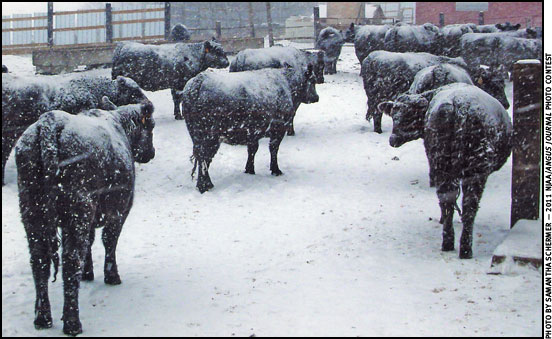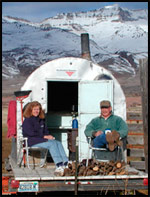MANAGEMENT...
 Another Bad Winter
Another Bad Winter
A strong La Niña may make this winter a "blockfest."
If you lived in the Midwest and remember last year's long and difficult winter, get ready for a repeat performance, says a University of Missouri (MU) atmospheric science researcher.
Tony Lupo, department chair and professor of atmospheric science in the School of Natural Resources, said the same La Niña jet stream and atmospheric blocking patterns that brought heavy snows and below-normal temperatures to the central states will probably remain in place for the winter of 2011-2012. Read more.

Ron Torell with his wife, Jackie
Cow Camp Chatter
Biological cycle of the beef cow
One of the most fundamental principles of beef cow management is understanding the biological cycle of the beef cow. This basic principle reveals how a cow's nutrient demands change at each stage of her production. With this specific knowledge under your hat, you as a manager will be better equipped to manage reproduction.
The biological cycle of the beef cow is constant and well-defined. It can be divided into four periods. The first, second and third trimesters of gestation are each 94 days in duration. Given this, the duration of a cow's pregnancy is approximately 282 days. In order for a cow to rebreed and calve at the same time the following year, the postpartum period should be no longer than 83 days. Read more.
Windbreaks
In northern climates, windbreaks can save cattlemen money by reducing feed costs, illness and health costs, and loss of body condition — as well as improving gains on young animals. When cattle are stressed by wind, they seek shelter. Not every ranch has brushy areas or draws the cattle can get into.
"Windbreaks improve efficiency — managing the environment for cattle," says Steve Paisley, Extension beef cattle specialist at the University of Wyoming. "If they are experiencing cold stress, they need to eat more." Read more.
Does Rectal Palpation Affect Pregnancy Loss?
There is feeling among some producers that rectal palpation to determine early pregnancy could cause physical trauma, resulting in loss of pregnancy. A study was conducted to determine the effect of palpation on pregnancy loss. The study was reported by Texas A&M University in the Journal of the American Veterinary Medical Association.
At approximately 31 days after estrus, dairy cows were diagnosed by ultrasound to be pregnant and were either palpated (n = 452) or not palpated (n = 476). In one-half of the palpated cows, fetal membranes were slipped once and in the other one-half fetal membranes were slipped twice. All cows were then ultrasounded at days 45 and 60 to determine viability of the embryo/fetus.
From Day 31 to Day 60, total loss was 14.5% for control, 12.6% for once slipped, and 14.9% for twice slipped. Of the total loss, in the same order of treatment, embryonic loss (Day 31 to Day 45) was 12.4%, 9.1%, and 9.5% and fetal loss (Day 45 to Day 60) was 2.4%, 3.8%, and 5.9%. The authors concluded that rectal palpation did not increase pregnancy loss.

Kris Ringwall
Beef Talk
First-cycle conception has been remarkably stable.
If one reviews the data through the last 21 years, what is remarkable is that there are no dramatic trends or up-and-down swings.
The percentage of cows that have calved in the first 21 days of the calving season for the last decade was 58, 60, 61, 62, 64, 64, 64, 64, 63 and 61%. The current CHAPS (Cow Herd Appraisal Performance Software) benchmark for mature cows calving in the first 21 days of the calving season is 63.4%. Read more.
Easements
Conservation easements offer way to keep land in farming.
Landowners who want to ensure that their farmland will be farmed for generations to come can consider a conservation easement to limit its future development even if they later sell the land.
A conservation easement is a voluntary agreement between a landowner and a land trust, a private, nonprofit organization that works to conserve the land. In this type of agreement, the landowner "gifts" the conservation easement to the land trust. The landowner, in turn, benefits from federal income tax deductions. Read more.
New Products
Industry affiliates provide a wide array of products and services to assist you on the farm and ranch. Here's an assortment of new products to hit the market recently.
- New BRD therapy approved
- Energy-free livestock waterer
- Mobile app for ag markets
- Smaller, faster tiller
Angus Advisor
Click here for December herd management tips from cattle experts across the nation. Advice separated by region.
[Click here to go to the top of the page.]










